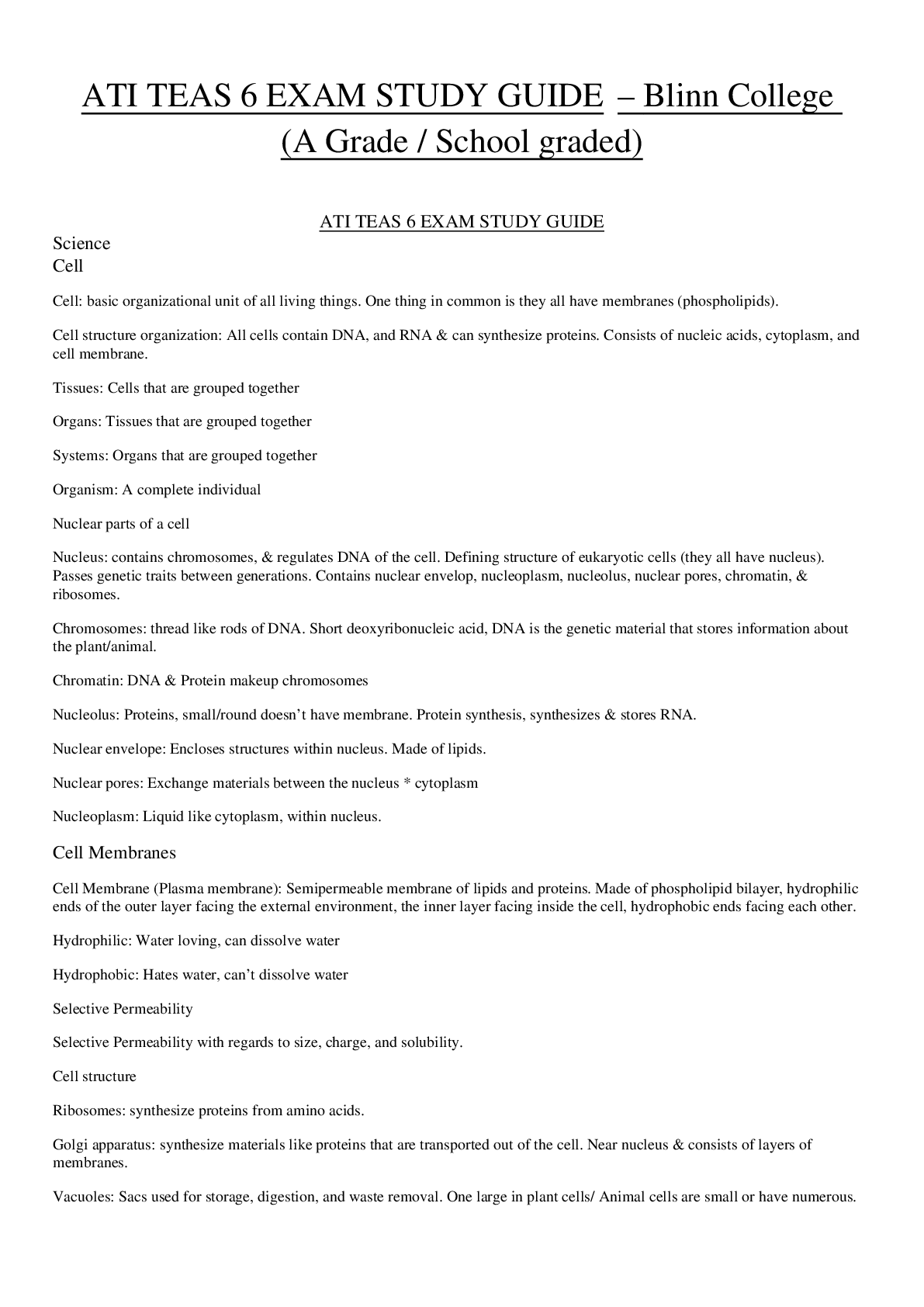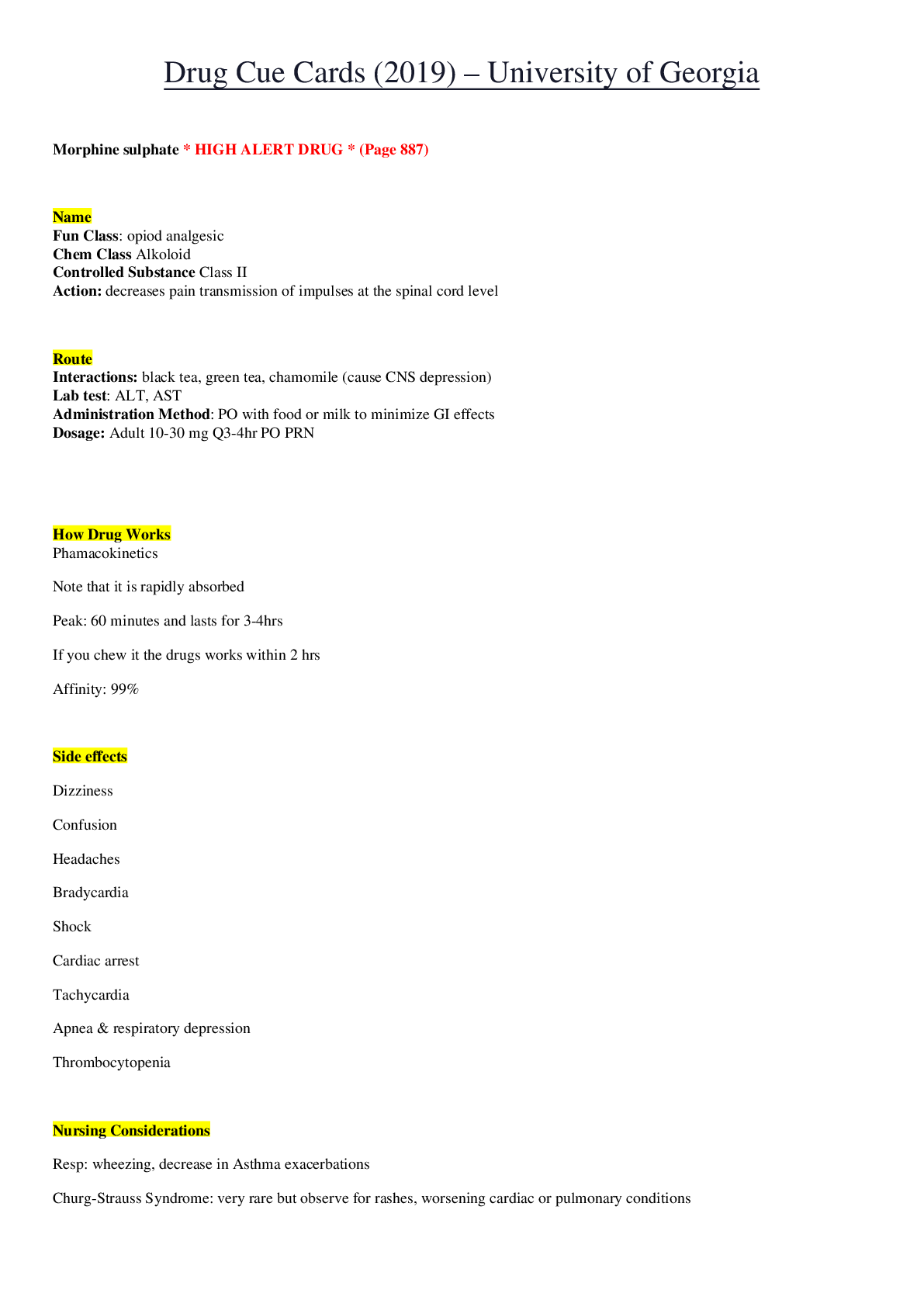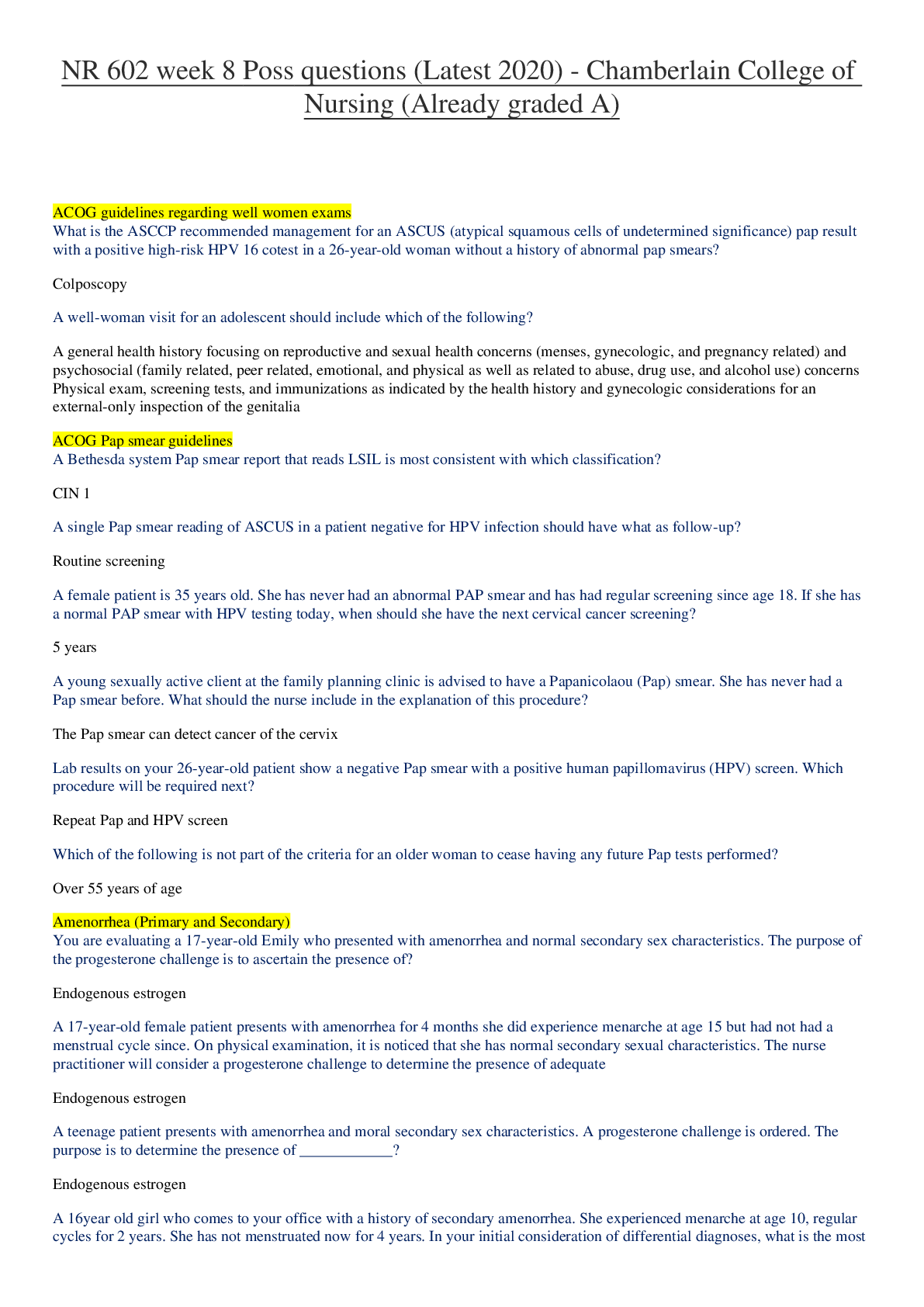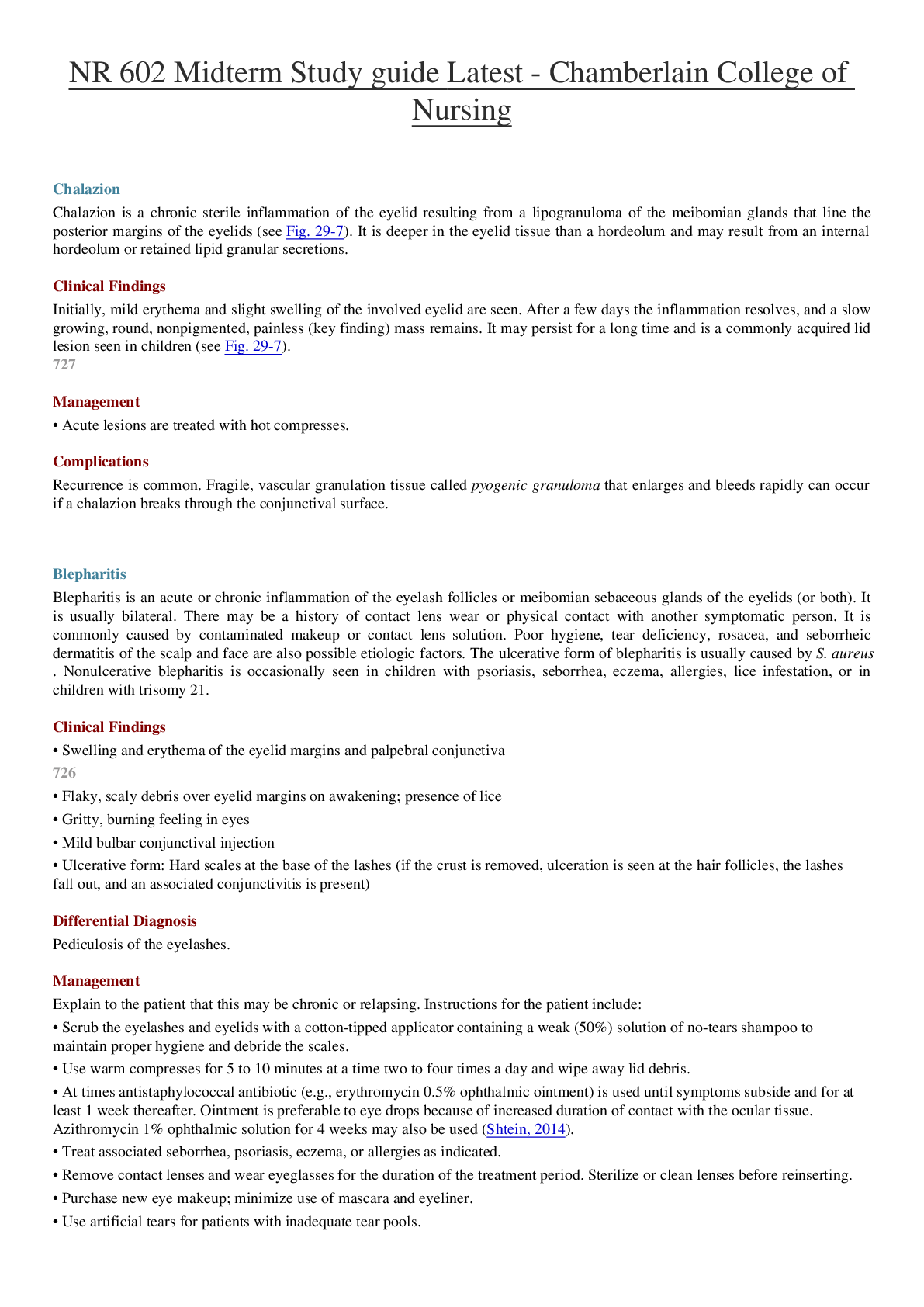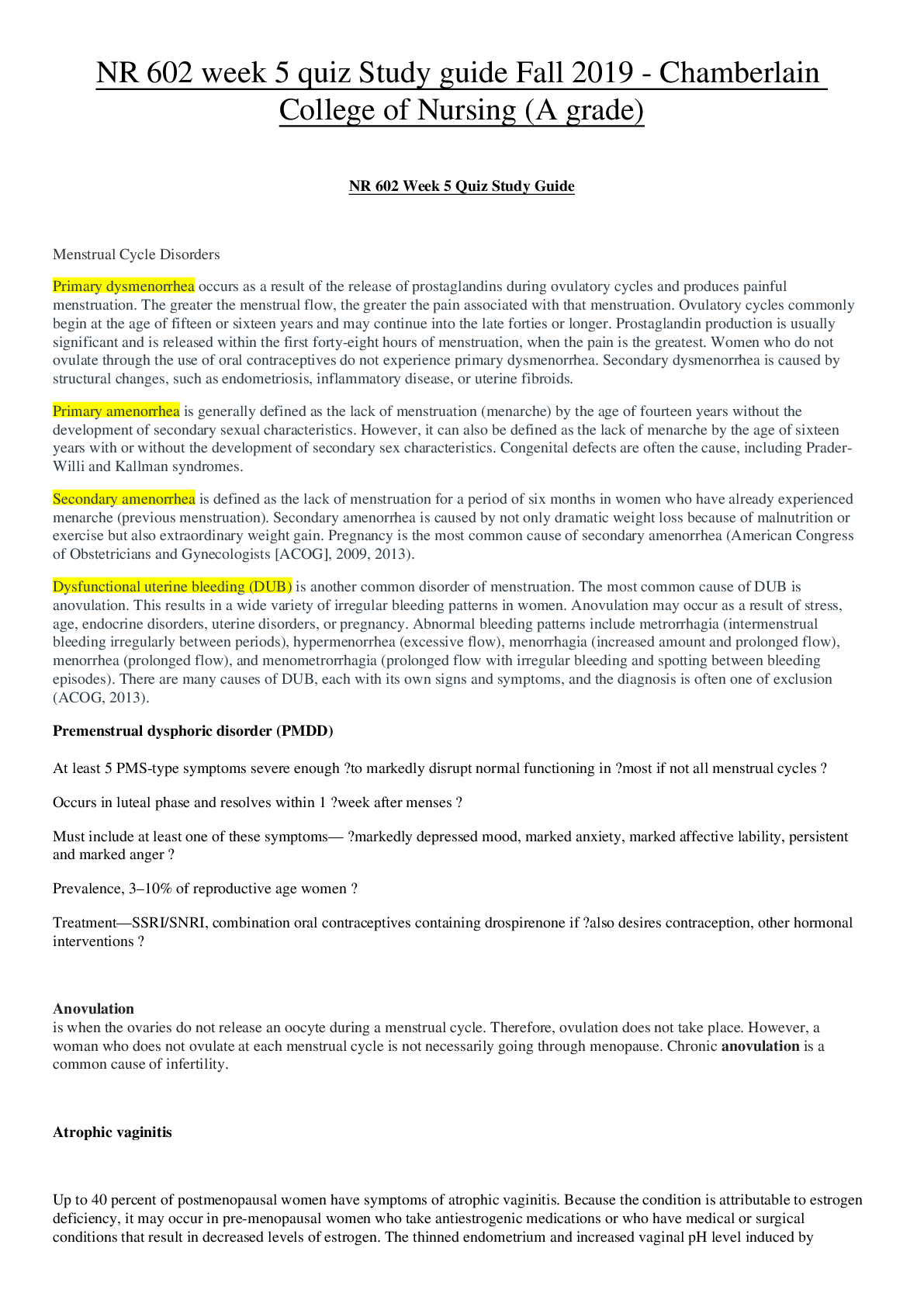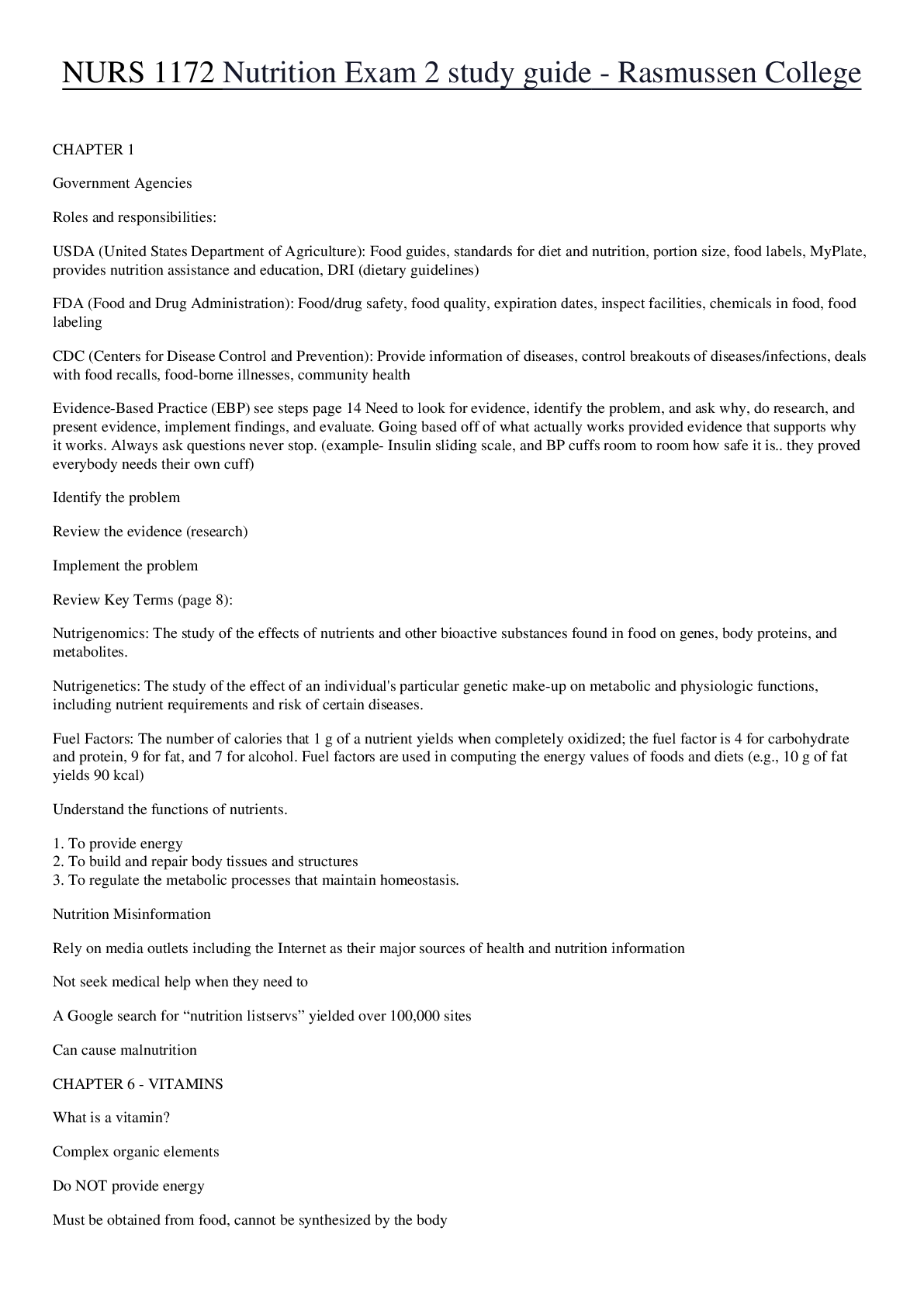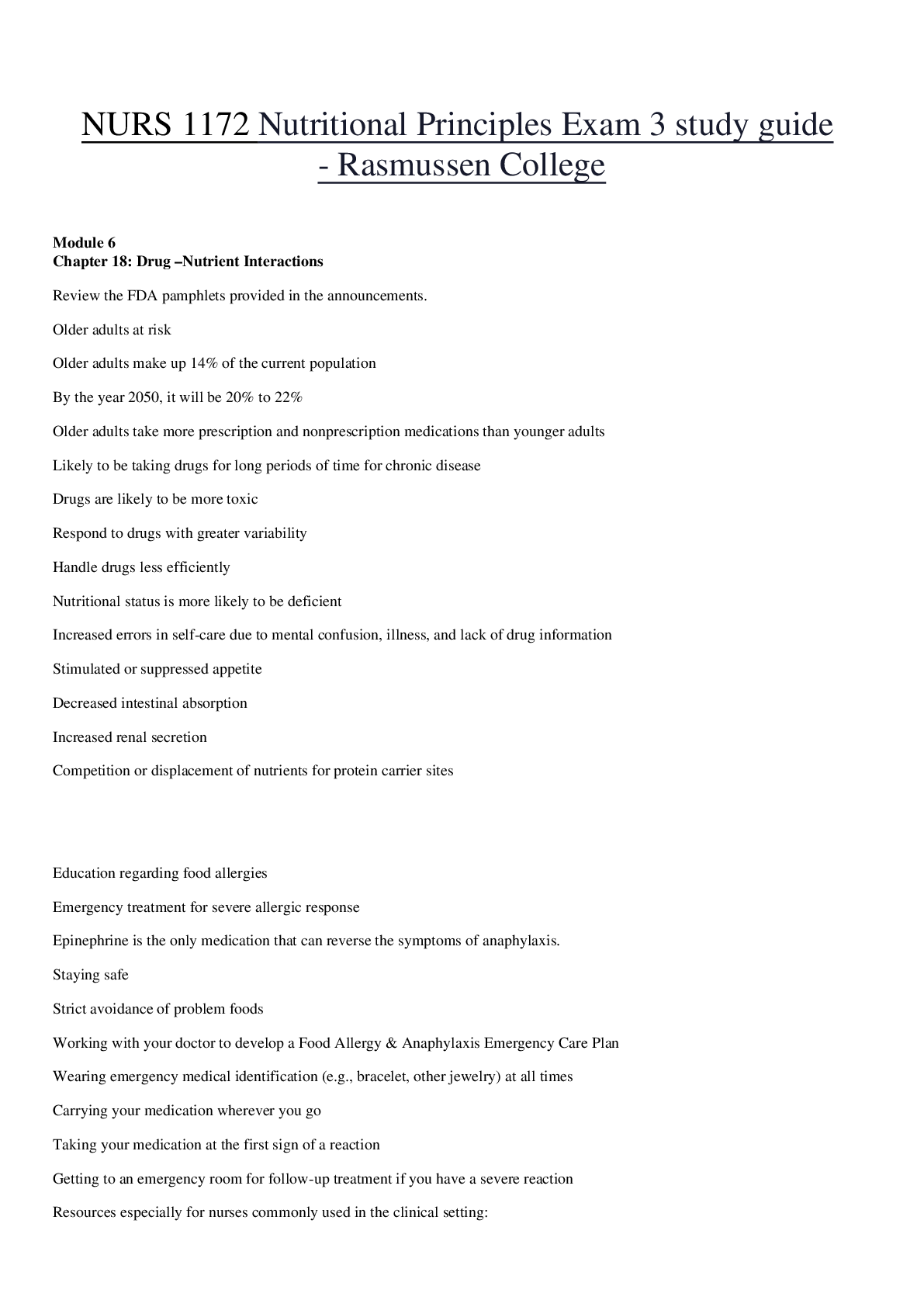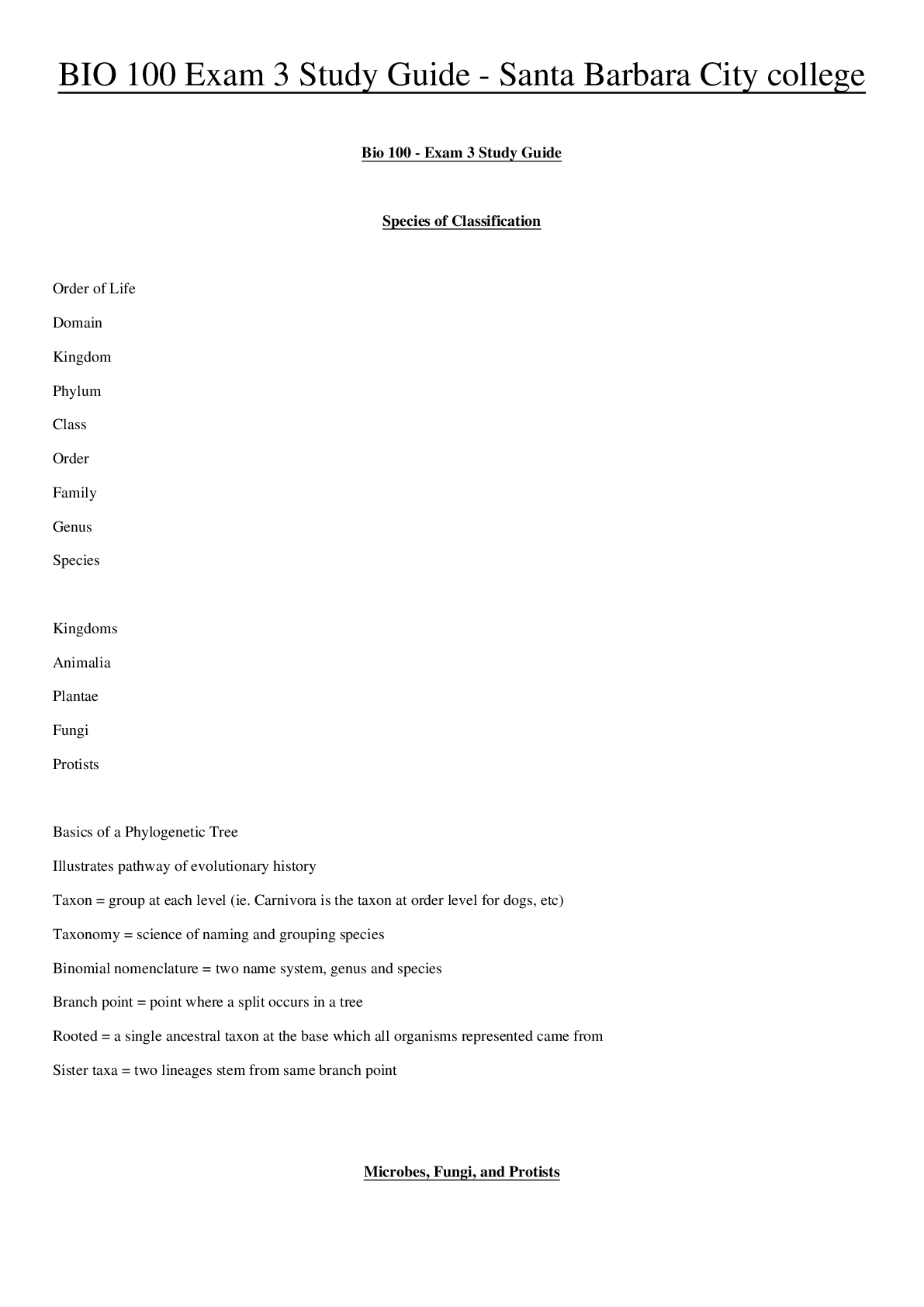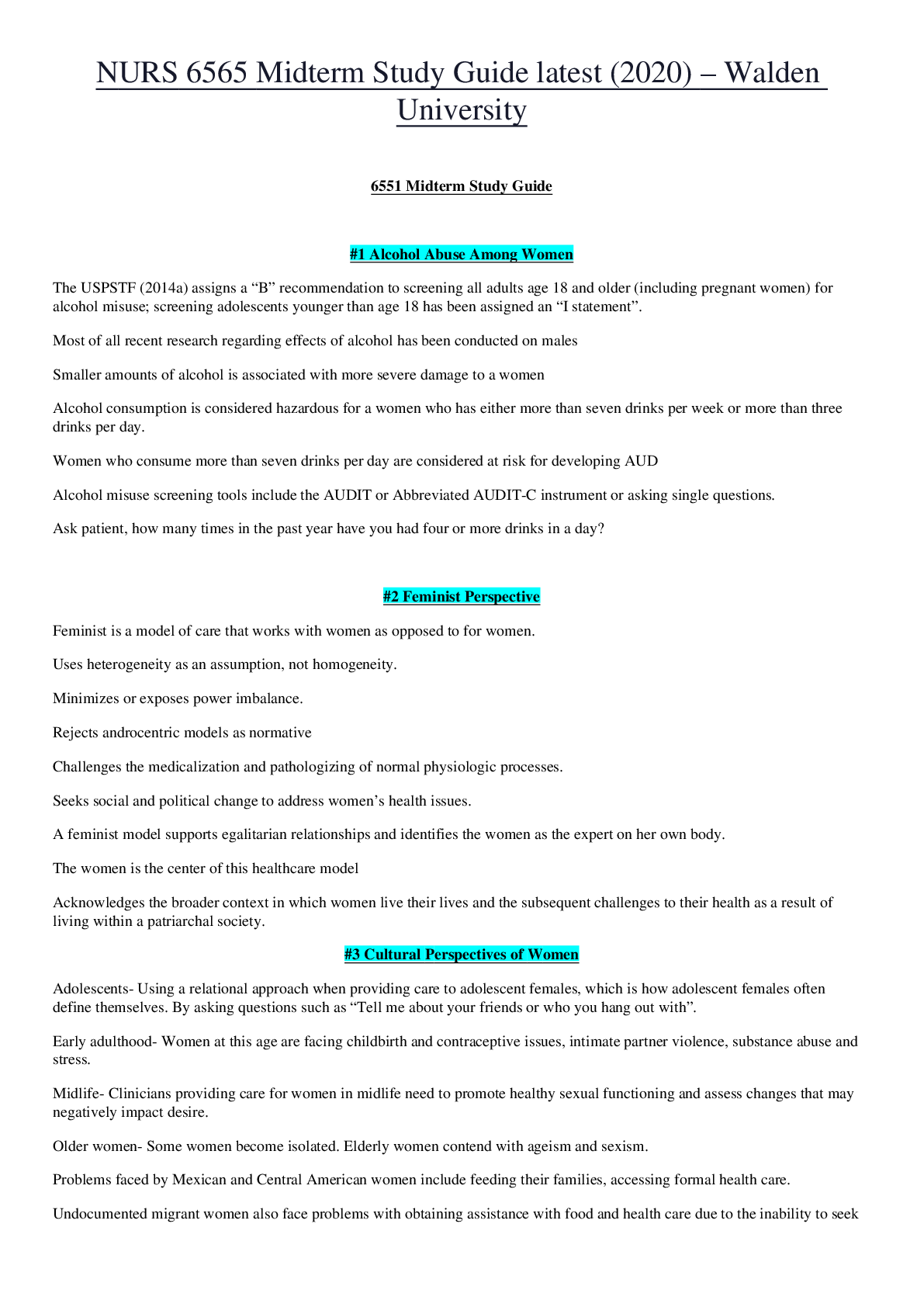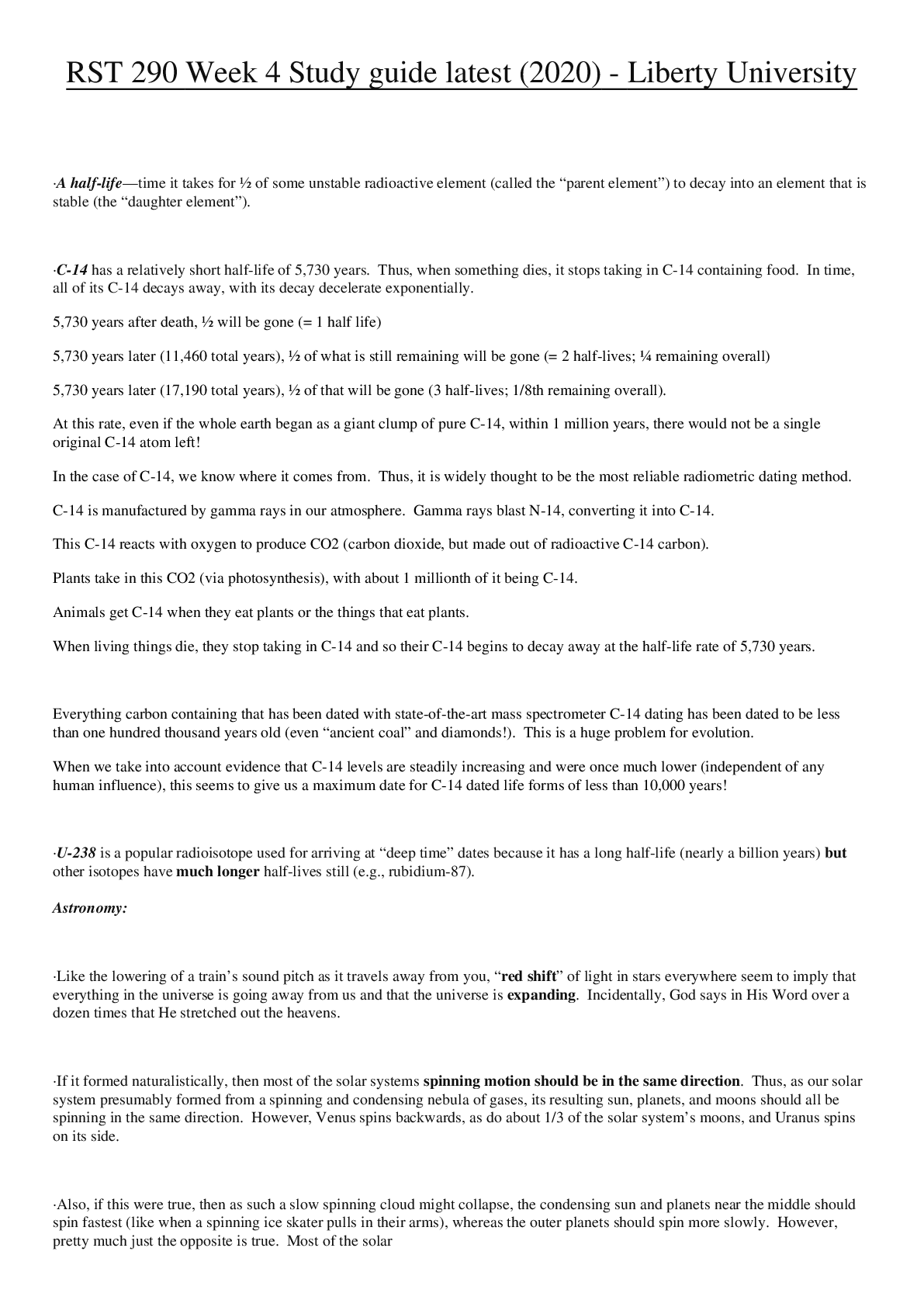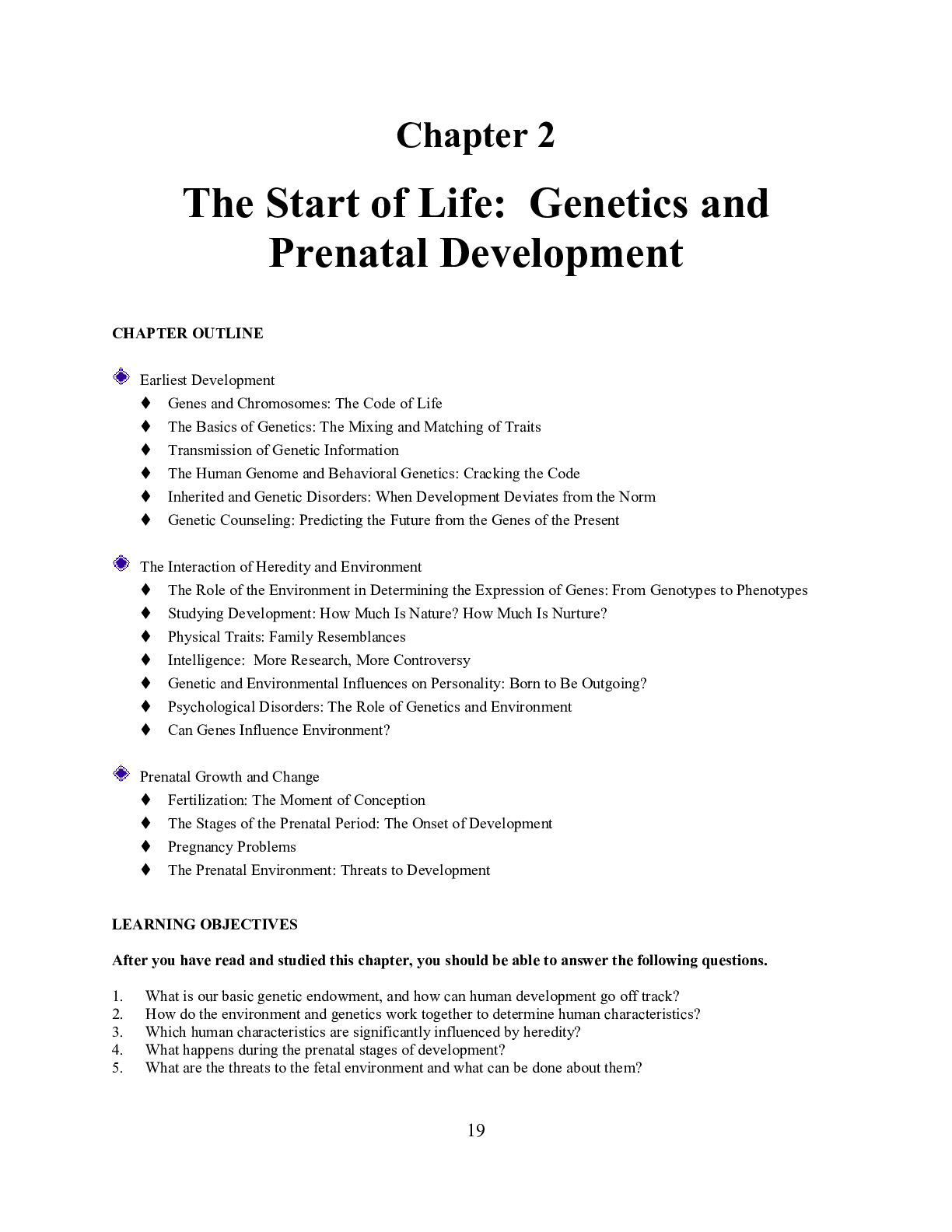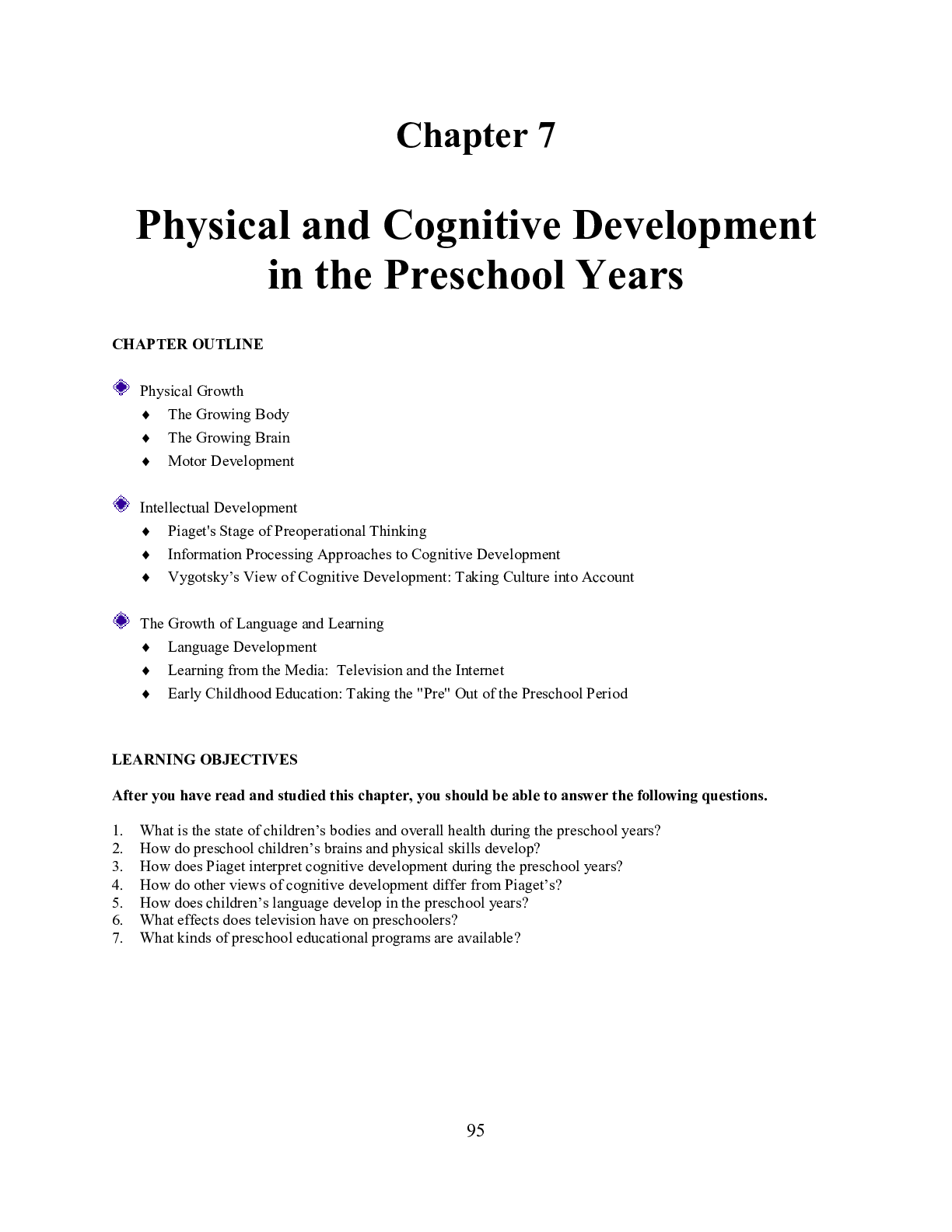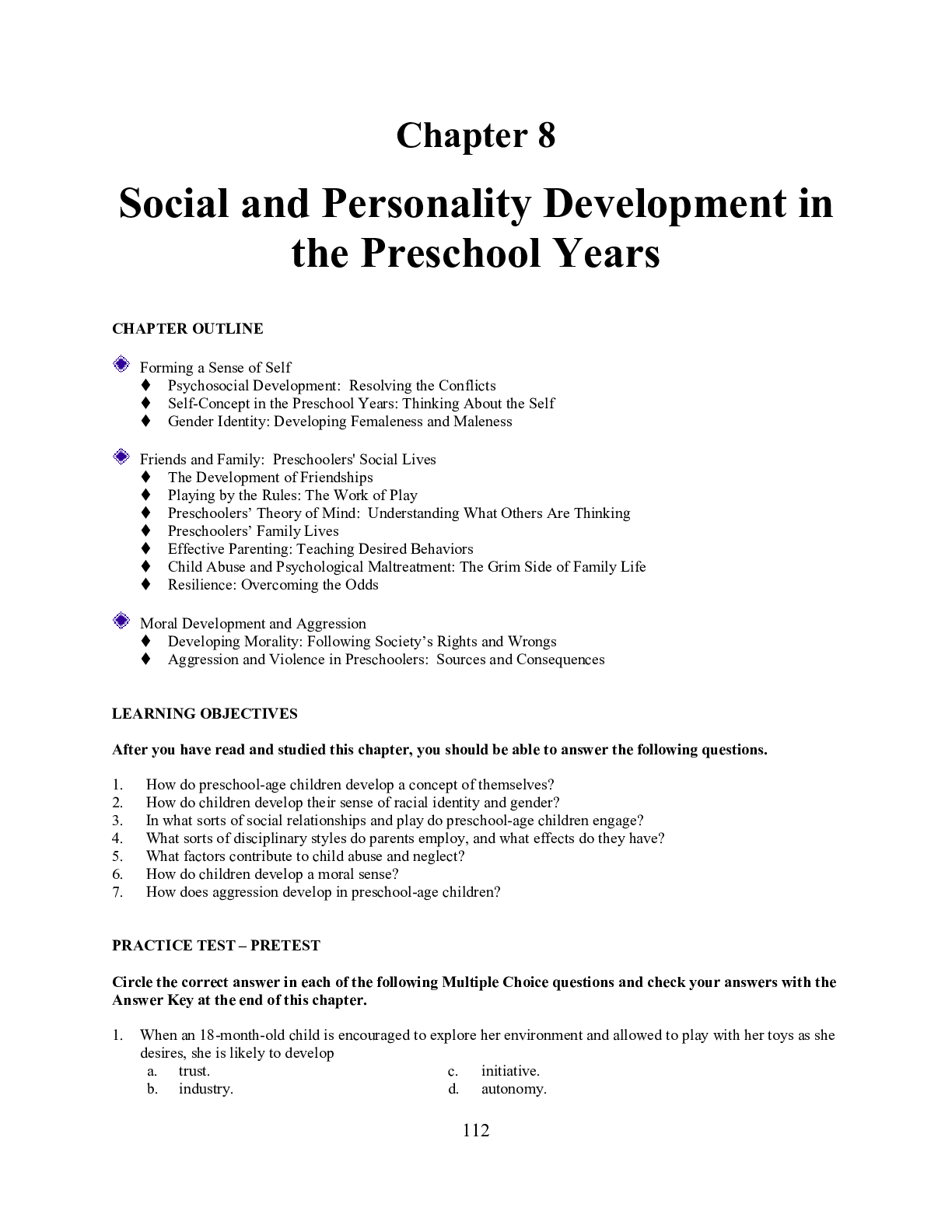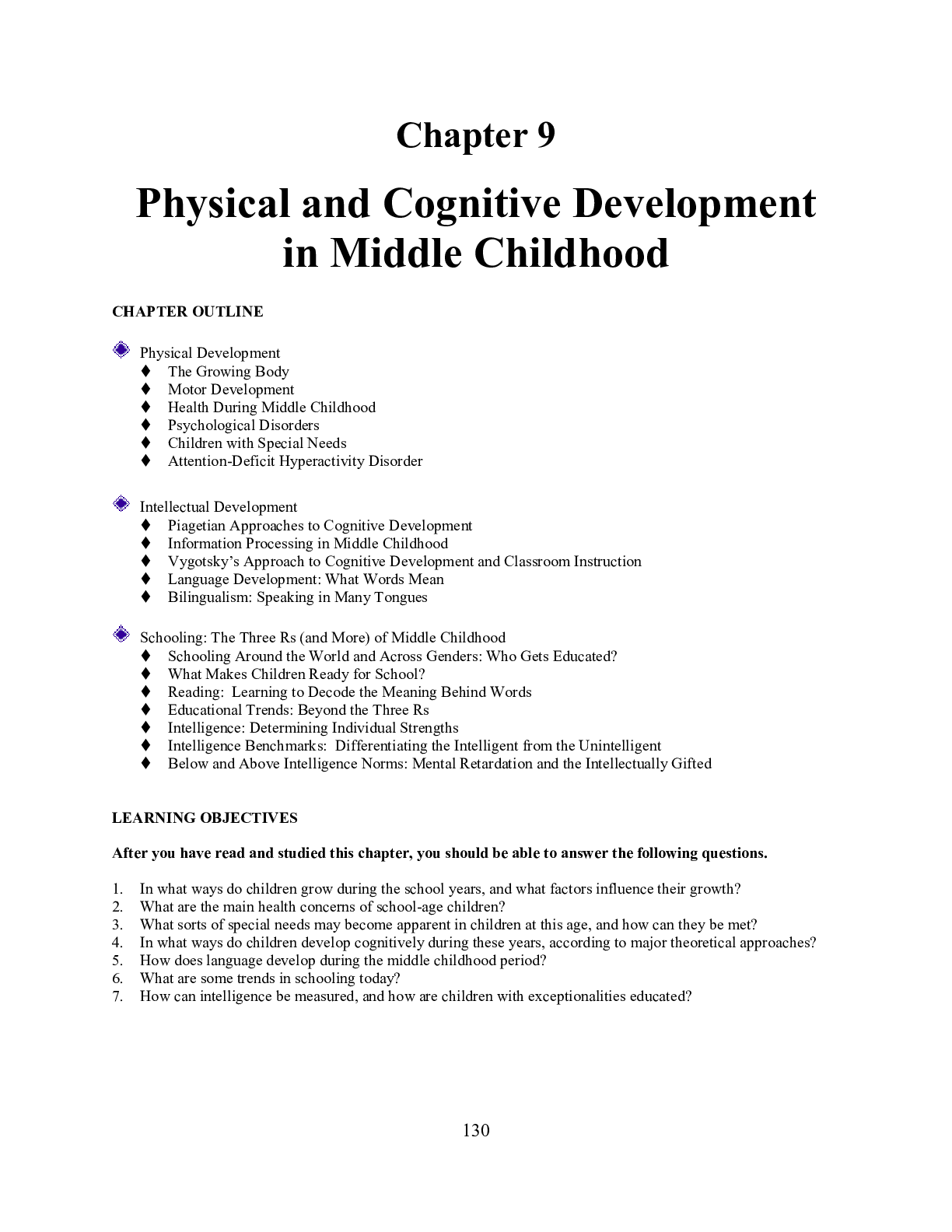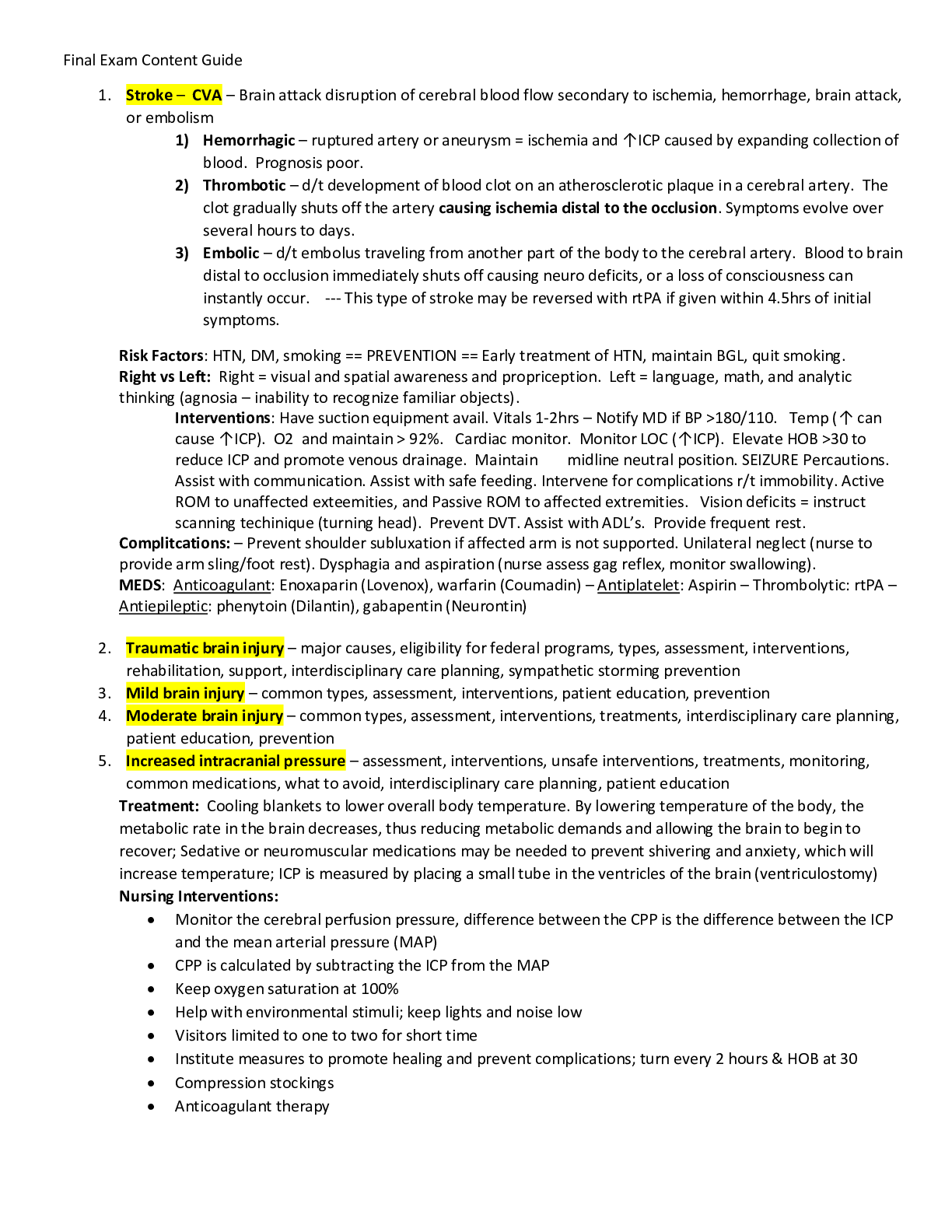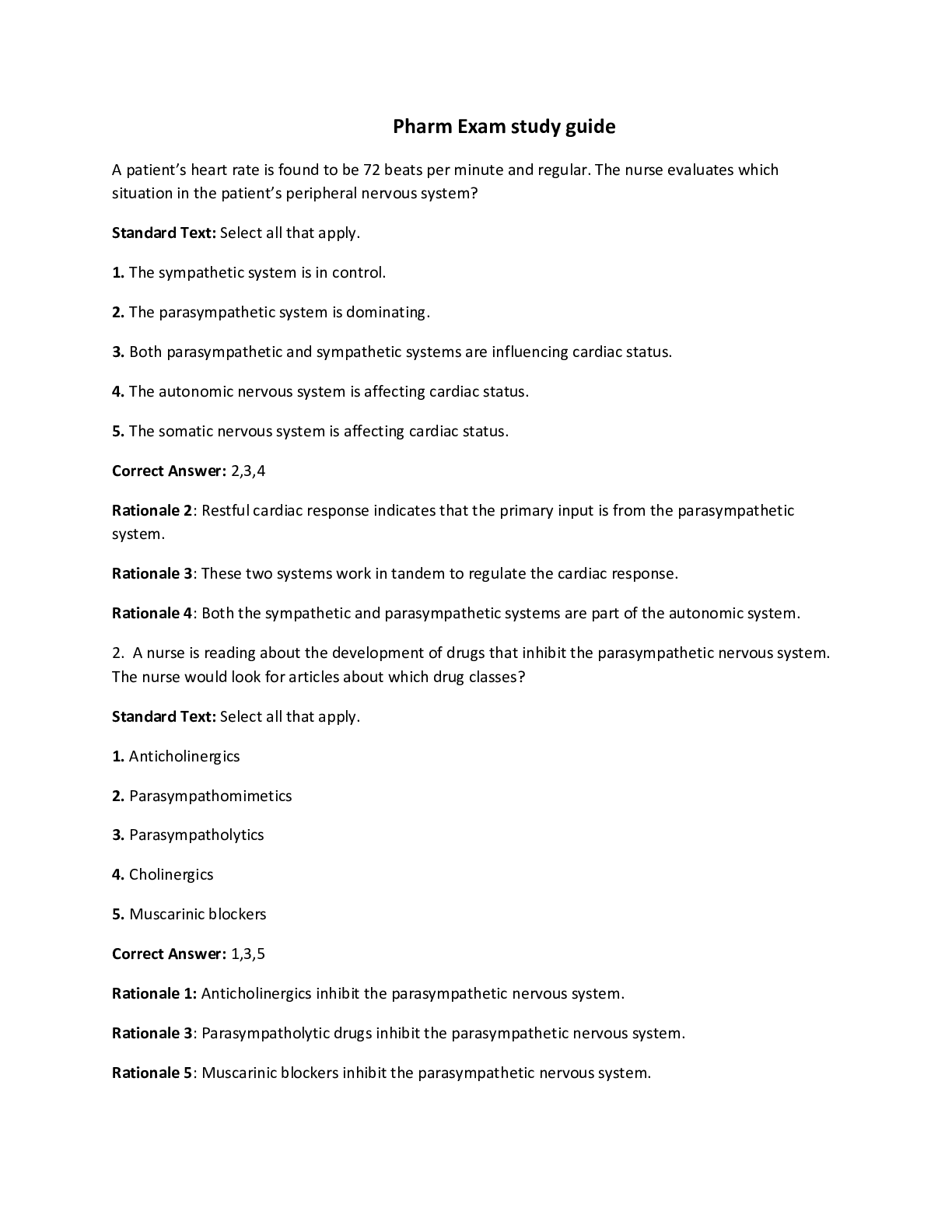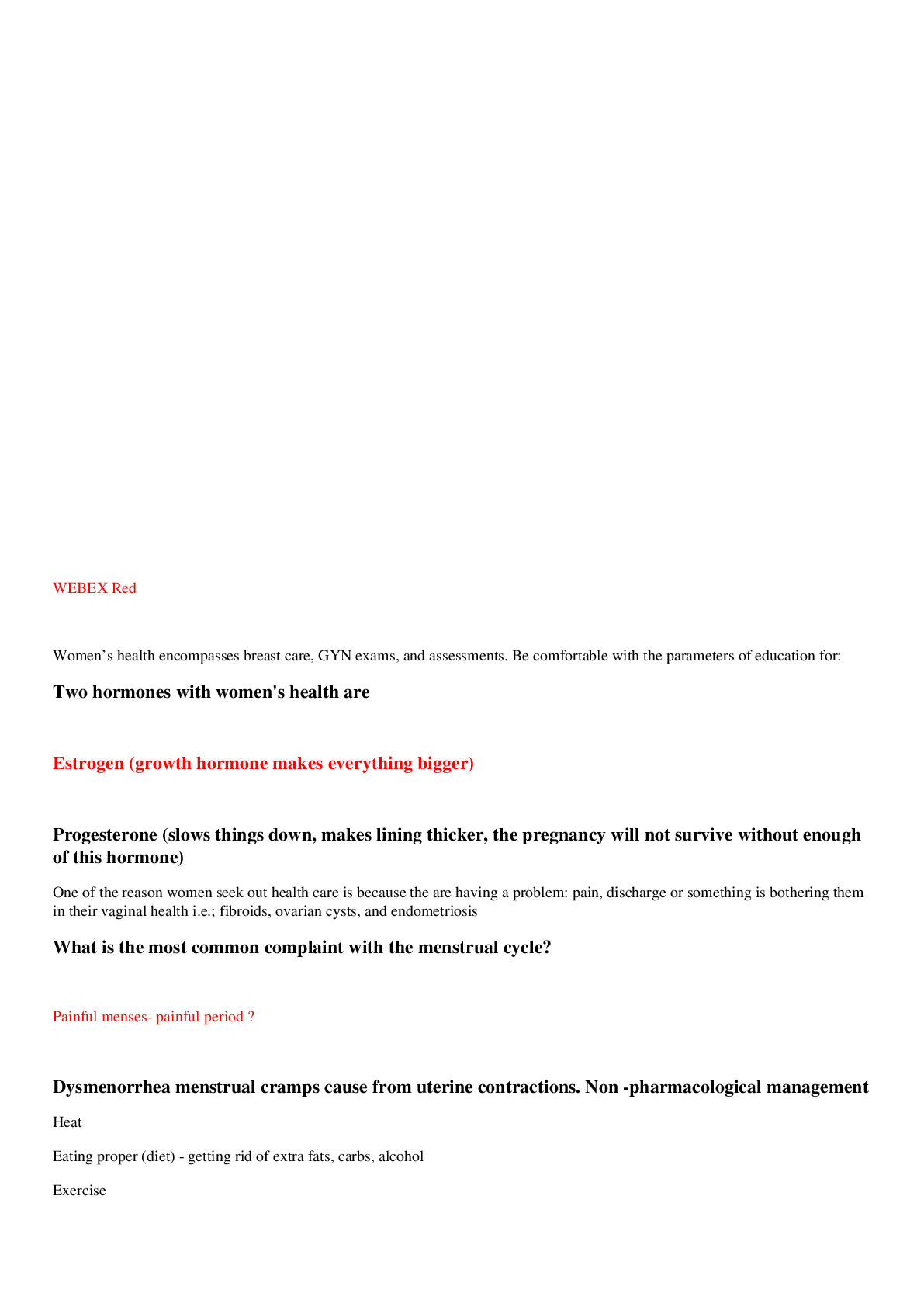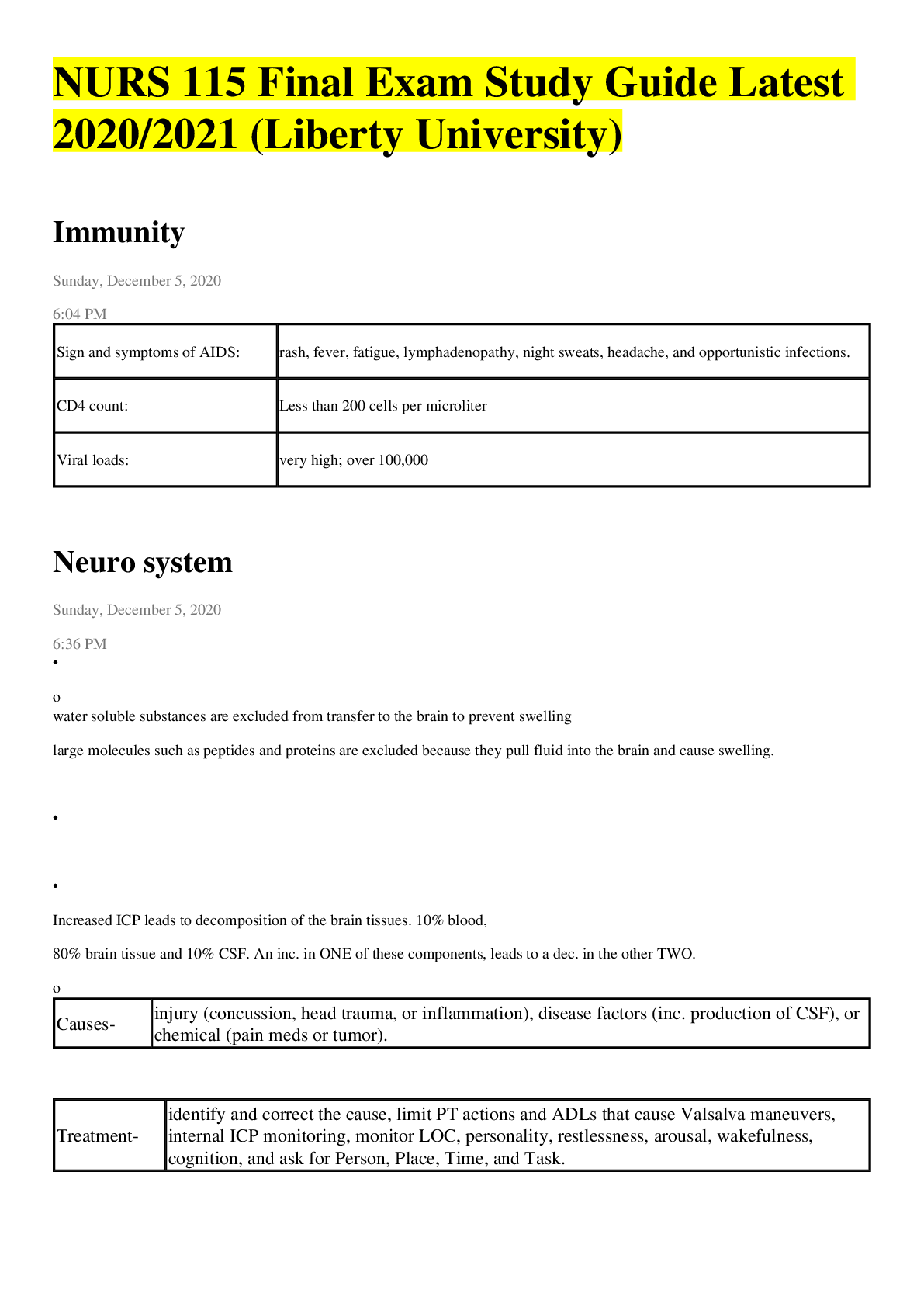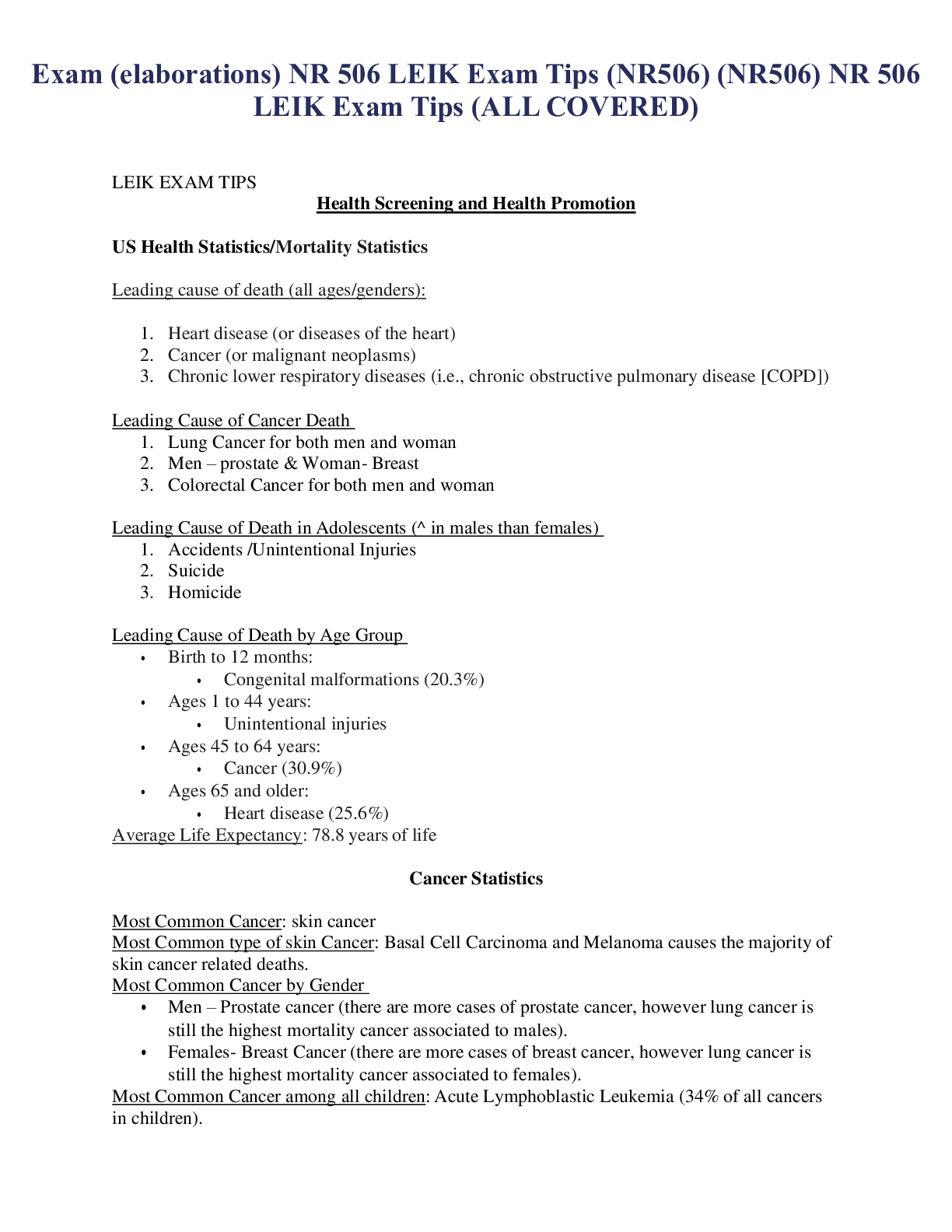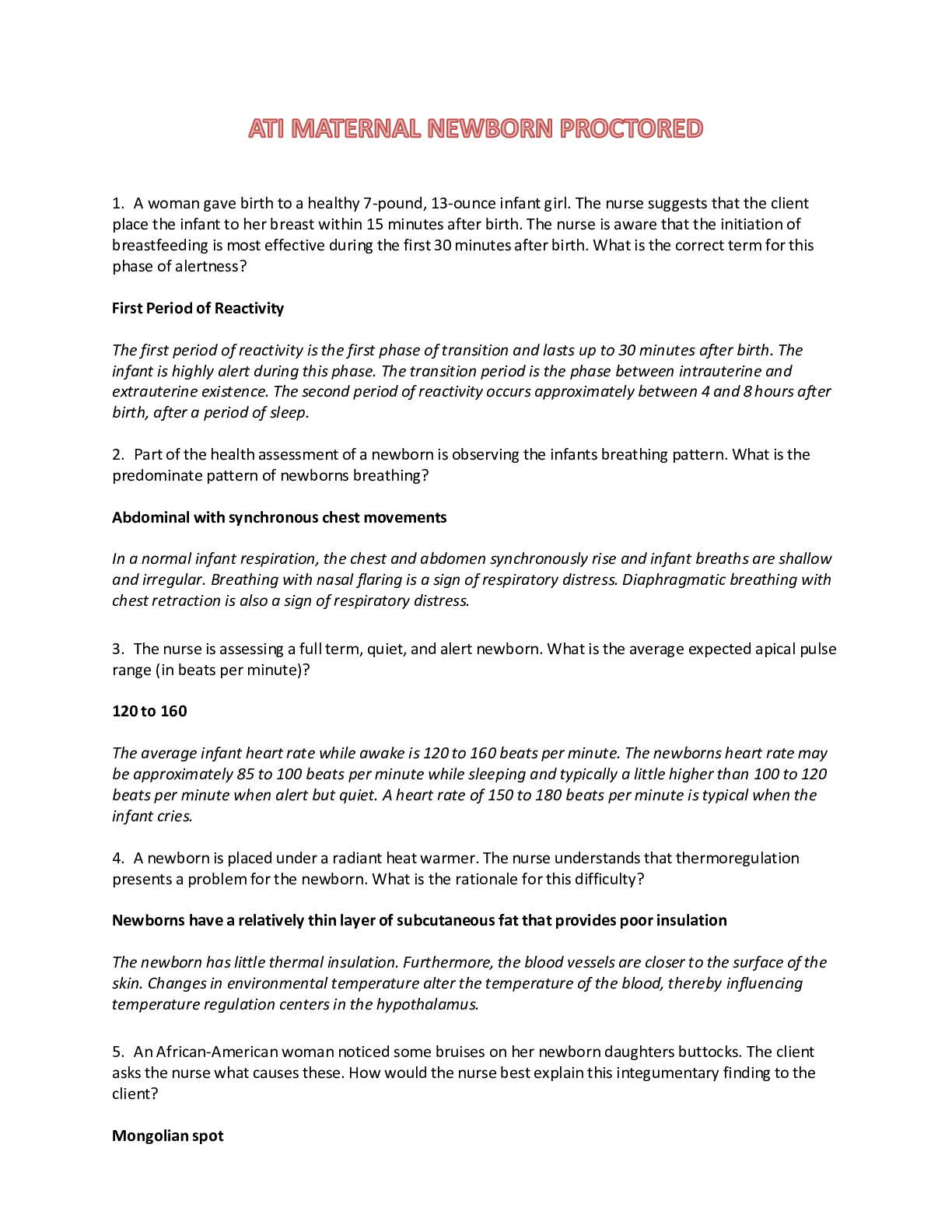Biology > STUDY GUIDE > BIOL 102 Chapter 5 Study guide latest 2020 - Liberty University / BIOL 102 Chapter 5 Study guide lat (All)
BIOL 102 Chapter 5 Study guide latest 2020 - Liberty University / BIOL 102 Chapter 5 Study guide latest 2020
Document Content and Description Below
BIOL 102 Chapter 5 Study guide latest 2020 - Liberty University Chapter 5 Cognitive Development in Infancy CHAPTER OUTLINE Piaget's Approach to Cognitive Development ♦ Key Elements of Piaget’... s Theory ♦ The Sensorimotor Period: The Earliest Stage of Cognitive Growth ♦ Appraising Piaget: Support and Challenges Information Processing Approaches to Cognitive Development ♦ Encoding, Storage, and Retrieval: The Foundations of Information Processing ♦ Memory During Infancy: They Must Remember This... ♦ Individual Differences in Intelligence: Is One Infant Smarter Than Another? The Roots of Language ♦ The Fundamentals of Language: From Sounds to Symbols ♦ The Origins of Language Development ♦ Speaking to Children: The Language of Infant-Directed Speech LEARNING OBJECTIVES After you have read and studied this chapter, you should be able to answer the following questions. 1. What are the fundamental features of Piaget's theories of cognitive development? 2. How do infants process information? 3. How is infant intelligence measured? 4. By what processes do children learn to use language? 5. How do children influence adults’ language? PRACTICE TEST – PRETEST Circle the correct answer for each of the following multiple choice questions and check your answer with the Answer Key at the end of this chapter. 1. Eight-month-old Angela picked up a crayon. She had never seen one before and did not know how to use it. She treated the crayon as if it were like her other toys, handling and mouthing it. Because she was functioning from her toy-manipulating schema, she a. assimilated the crayon into her existing schemes. b. adapted to the crayon with a tertiary circular schema. c. accommodated the crayon into her existing schemes. d. adapted to the crayon with a secondary circular schema.66 2. If Piaget designed an early educational program, he would be most likely to focus on a. the environment. b. direct motor behavior. c. facts communicated by others. d. learning through sensation and perception. 3. When Michael cannot directly see his mother, he does not understand that she still exists. This illustrates a lack of which of Piaget’s sensorimotor concepts? a. object permanence c. infantile amnesia b. differed imitation d. goal-directed behavior 4. Rebecca copies the behavior of her mother, who is no longer present. Rebecca's actions are called a. mirror imaging. c. deferred imitation. b. object permanence. d. stimulus substitution. 5. Most people cannot remember their early childhood. This is called infantile amnesia and is defined as the lack of memory for experiences that occurred prior to a. birth. c. 12 months of age. b. 6 months of age. d. 3 years of age. 6. An overall developmental score that relates to performance on motor skills, language use, adaptive behavior, and personal-social domains is called the a. mental age. c. intelligence quotient. b. chronological age. d. developmental quotient. 7. Many children get frustrated because they know what they want to express but they cannot say it. This is due to the fact that a. production precedes comprehension. b. comprehension precedes production. c. comprehension does not always occur with articulation. d. comprehension and production are not part of the child’s repertoire. 8. Juan has spoken his first words. We would expect that an infant developing normally would reach this milestone at approximately a. 6-8 months. c. 10-14 months. b. 8-10 months. d. 14-18 months. 9. When 2-year-old Christine speaks, she leaves out words like “to.” For example, if she wants something she will say “give me,” instead of “give that to me.” This language is called a. egocentric speech. c. holophrastic speech. b. telegraphic speech. d. infant-directed speech. 10. When a child is not able to see that a general term like “dog” can apply to more dogs than just to her German shepherd, the child is experiencing a normal developmental aspect of language called a. overextending. c. underextending. b. overregulating. d. underregulating. 11. Which theory of language acquisition is most fully supported by research? a. learning theory b. interactionist approach c. nativist perspective d. universal grammar67 12. According to Piaget, an organized pattern of sensorimotor functioning is a(n) a. scheme. c. holophrase. b. reaction. d. expression. 13. Vicky has just begun to coordinate separate actions into single, integrated activities. What substage of sensorimotor development is Vicky in? a. one c. three b. two d. four 14. Who suggested that cognitive development proceeds in waves rather than stages? a. Jean Piaget b. Noam Chomsky c. Robert Siegler d. Nancy Bayley 15. What is the second step of memory, according to the information processing approach? a. consciousness c. cognition b. retrieval d. storage 16. The degree to which an activity requires attention is a. conceptualization. c. intellectualization. b. accommodation. d. automization. 17. Piaget focused on ______ changes, whereas the information processing approach focused on _______ change. a. qualitative; quantitative c. referential; expressive b. quantitative; qualitative d. expressive; referential 18. Three formal characteristics of language that must be mastered are a. morphemes, phonology, and semantics. b. pragmatics, phonology, and semantics. c. nouns, verbs, and prepositions. d. adjectives, subject, and verbs. 19. Which of the following statements is TRUE regarding gender and infant language development? a. Girls are prone to hear twice as many diminutives as boys. b. Boys are prone to hear twice as many diminutives as girls. c. Girls hear firmer, clearer language than do boys. d. Language is largely unaffected by gender. 20. Noam Chomsky is associated with all of the following EXCEPT a. nativist approach. c. universal grammar. b. infant-directed speech. d. language acquisition device. KEY NAMES Match the following names with the most accurate description and check your answers with the Answer Key at the end of this chapter. 1. ___ Nancy Bayley a. developmental quotient 2. ___ Noam Chomsky b. gender differences in speech 3. ___ Arnold Gesell c. LAD 4. ___ Jean Berko Gleason d. scales of infant development - - - - - - - - - - - 9. Laura says "kitty" whenever she sees a four-legged animal. This is an example of an aspect of speech called a. overextending. c. underextending. b. overregulating. d. underregulating. 10. Which type of speech is also known as motherese? a. telegraphic speech c. infant-directed speech b. holophrastic speech d. underextended speech 11. When a child begins to conduct trial-and-error experiments, she is in what sensorimotor stage? a. reflexes c. tertiary circular reactions b. secondary circular reactions d. the coordination of object permanence 12. Amit’s ability to tie her shoes with without conscious cognitive effort demonstrates her a. memory decoding. c. implicit memory. b. explicit memory. d. infantile amnesia. 13. The combination and coordination of several schemes to generate a single act to solve a problem is a. tertiary circular reactions. c. object-directed behavior. b. secondary circular reactions. d. goal-directed behavior. 14. Critics of Piaget’s theory have stated all of the following EXCEPT a. development proceeds in a much more continuous fashion. b. the theory ignores the importance of sensory and perceptual systems. c. facial imitation does not begin until age 2 years. d. object permanence can be mastered earlier than the theory states. 15. Which of the following is NOT an element of information processing? a. encoding c. retrieval b. decoding d. storage 16. The Bayley Scales of Infant Development evaluate all of the following EXCEPT a. fine motor skills. c. intelligence quotient. b. problem solving. d. gross motor skills. 17. The notion that all of the world’s languages share a similar underlying structure was described by Chomsky as a. common communication. c. universal grammar. b. global semantics. d. the LAD. 18. Prelinguistic communication includes all of the following EXCEPT a. gestures. c. sounds. b. facial expressions. d. words. 19. Sara is learning to talk and her vocabulary consists primarily of words used to label objects. Her language style is a. overextended. c. referential. b. linguistic. d. expressive.76 20. As a child reaches the end of the first year, infant-directed speech a. increases dramatically. b. involves longer, more complex sentences. c. is directed at girls but no longer at boys. d. stops completely. LEARNING OBJECTIVES REVISITED 1. What are the fundamental features of Piaget's theories of cognitive development? • Jean Piaget’s stage theory asserts that children pass through stages of cognitive development in a fixed order. The stages represent changes not only in the quantity of infants’ knowledge, but in the quality of that knowledge as well. • According to Piaget, all children pass gradually through the four major stages of cognitive development (sensorimotor, preoperational, concrete operational, and formal operational) and their various substages when they are at an appropriate level of maturation and are exposed to relevant types of experiences. • In the Piagetian view, children’s understanding grows through assimilation of their experiences into their current way of thinking or through accommodation of their current way of thinking to their experiences. • During the sensorimotor period (birth to about 2 years) with its six substages, infants progress from the use of simple reflexes, through the development of repeated and integrated actions that gradually increase in complexity, to the ability to generate purposeful effects from their actions. By the end of the sixth substage of the sensorimotor period, infants are beginning to engage in symbolic thought. 2. How do infants process information? • Information processing approaches to the study of cognitive development seek to learn how individuals receive, organize, store, and retrieve information. Such approaches differ from Piaget’s by considering quantitative changes in children’s abilities to process information. • Infants have memory capabilities from their earliest days, although the accuracy of infant memories is a matter of debate. 3. How is infant intelligence measured? • Traditional measures of infant intelligence, such as Gesell’s developmental quotient and the Bayley Scales of Infant Development, focus on average behavior observed at particular ages in large numbers of children. • Information processing approaches to assessing intelligence rely on variations in the speed and quality with which infants process information. 4. By what processes do children learn to use language? • Prelinguistic communication involves the use of sounds, gestures, facial expressions, imitation, and other nonlinguistic means to express thoughts and states. Prelinguistic communication prepares the infant for speech. • Infants typically produce their first words between the ages of 10 and 14 months. At around 18 months, children typically begin to link words together into primitive sentences that express single thoughts. Beginning speech is characterized by the use of holophrases, telegraphic speech, underextension, and overextension.77 • The learning theory approach to language acquisition assumes that adults and children use basic behavioral processes—such as conditioning, reinforcement, and shaping—in language learning. A different approach proposed by Chomsky holds that humans are genetically endowed with a languageacquisition device, which permits them to detect and use the principles of universal grammar that underlie all languages. 5. How do children influence adults’ language? • Adult language is influenced by the children to whom it is addressed. Infant-directed speech takes on characteristics, surprisingly invariant across cultures, that make it appealing to infants and that probably encourage language development. • Adult language also exhibits differences based on the gender of the child to whom it is directed, which may have effects that emerge later in life. [Show More]
Last updated: 1 year ago
Preview 1 out of 15 pages
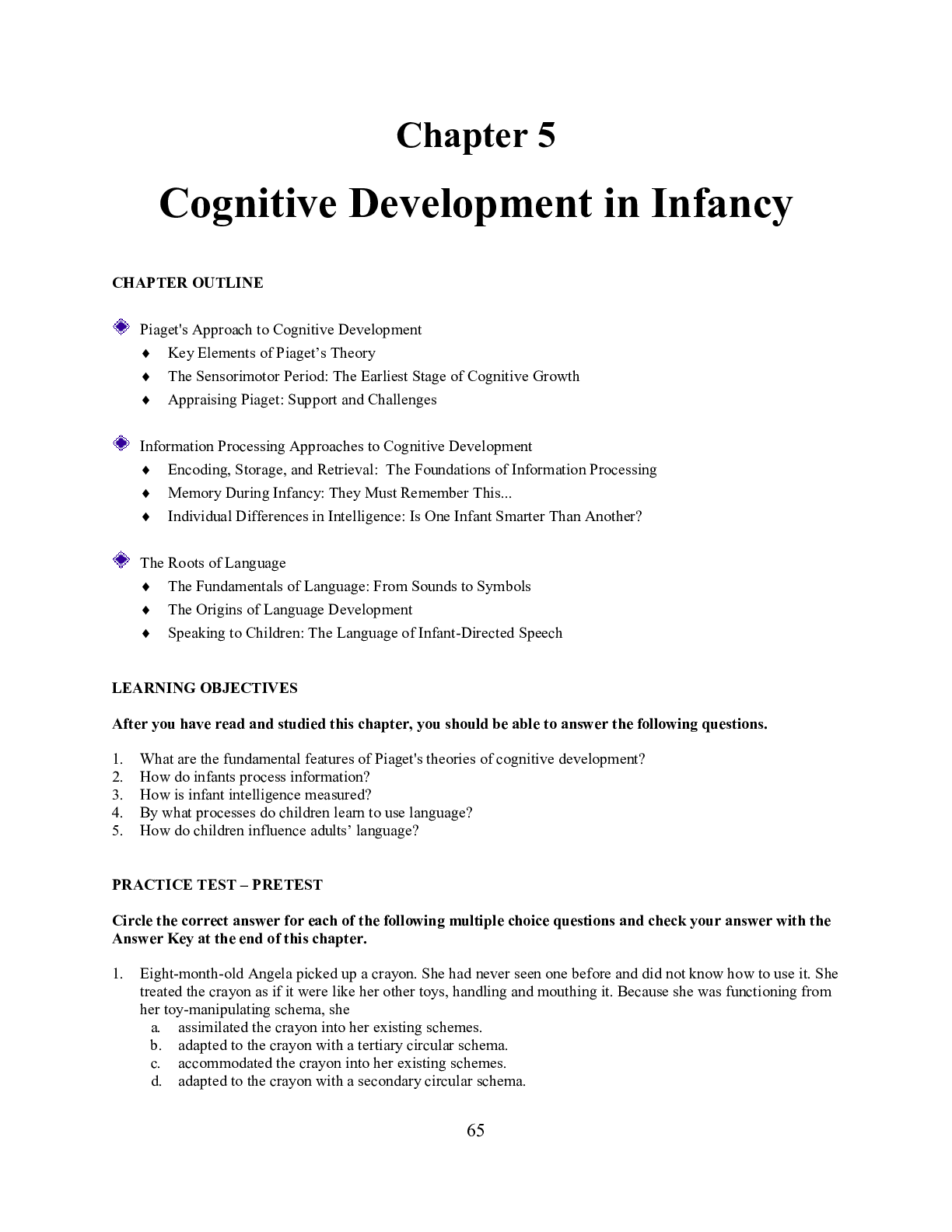
Reviews( 0 )
Document information
Connected school, study & course
About the document
Uploaded On
May 28, 2020
Number of pages
15
Written in
Additional information
This document has been written for:
Uploaded
May 28, 2020
Downloads
0
Views
42

